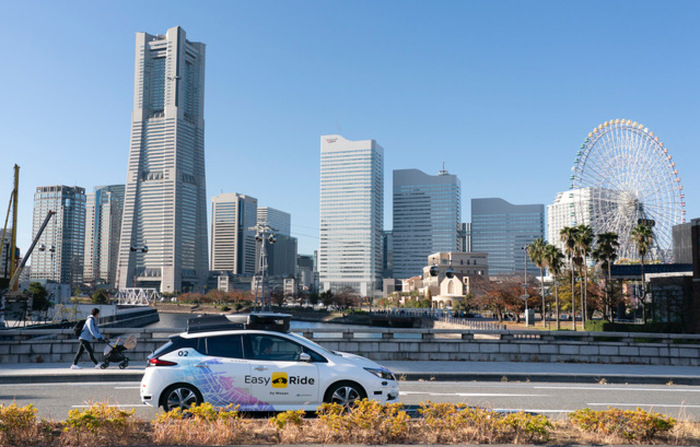Book a robotaxi on a mobile app and it will pick you up in less than 10 minutes.
It's 2:00pm on a Thursday in Beijing and our ride is going smoothly with no human intervention so far.
“Sometimes we have to speed up manually to avoid causing traffic jams.
Bicycles and motorcycles often cause traffic congestion because they ignore traffic signals,” says the driver supervising our trip, as the steering wheel magically moves by itself.
The 37-square-mile (60 square kilometers) Beijing High-level Automated Driving Demonstration Area (BJHAD) is where the country's first pilot project to use autonomous vehicles on public roads is happening.
Located in a secluded district in the southeastern part of the city, BJHAD is the test site for a futuristic plan that envisions turning Beijing into the standard-bearer for artificial intelligence (AI).
The Apollo robotaxis manufactured by Baidu and the autonomous delivery vehicles manufactured by JD.com (aka Jingdong) zip around a tranquil utopia that stands in stark contrast to the hectic jungle of downtown traffic.
“[A robotaxi] can handle an average of 15 daily bookings, most of which are trips between a subway stop and an office,” said the cab driver.
In November 2021, Baidu and Pony.ai became the first companies authorized to operate a fleet of 100 robotaxis in BJHAD.
As of April 2022, humans are no longer required to sit in the driver's seat of the robotaxi, which is allowed to travel at a maximum speed of 37 miles per hour (60 kph).
The service is free for now, although the two companies are commercially licensed.
Baidu, China's leading search engine, is diversifying its business by commercializing its AI and intelligent transportation technology.
Its Apollo Go program is currently operating in seven cities, and the company plans to expand to 65 cities by 2025, and 100 cities by 2030. Unlike the Waymo robotaxis that Google began operating in 2020 in the US, Baidu's vehicles circulate during the day, enabling them to collect more data.
Although Baidu has topped the list of Chinese companies with the most patents for AI applications over the last four years, e-commerce giant JD.com is the leader in the autonomous delivery vehicle space.
In 2016, Jingdong established its headquarters in BJHAD, and its delivery robots now dominate the streets.
These vehicles mainly transport orders from the 7FRESH smart supermarket chain operated by JD that combines e-commerce and traditional commerce.
“Instead of people going out to buy products, we deliver them,” said Yang Han. Who works in Jingdong's communications department.
JD's applies big data analytical methods to the information collected from more than 400 million annual users, and uses it to tailor inventories to the specific needs of each 7FRESH physical stores location.
The entire 7FRESH inventory is available in the app.
The delivery robots, which travel at nine miles per hour (15 kph) and can carry 220-440 pounds (100-200 kilos), deliver orders in less than an hour within a three-mile (five kilometer) range.
JD employees rely on smaller robots to send documents and other items between offices in 10 minutes or less.
“They speed up the work and saves us from having to run around from one place to another,” said Yang Han. The robots are able to operate elevators and open doors by themselves as they follow their delivery routes.
The robots can recognize their surroundings and avoid obstacles with a 98% accuracy rate for small objects.
Information streams in through cameras and other sensors, while the navigation algorithm pinpoints their location and plans routes.
JD's cloud-based simulation platform accumulates data from every trip to continuously improve the robots' capabilities.
The Covid pandemic spurred JD to accelerate its autonomous delivery program, enabling it to deploy small and large delivery vehicles to the Chinese cities most affected by the pandemic over the last two and a half years.
In early 2020, during the peak of the pandemic in Wuhan, these delivery vehicles traveled a total of 4,225 miles (6,800 kilometers) and delivered more than 13,000 packages.
In a country where low unemployment is one of the main pillars of its social stability goals, the move to autonomous vehicles may prove to be risky in the long run.
However, Yang Han insists that the objective is to “achieve a synergy between humans and machines… The goal is to take the pressure off delivery drivers and allow them to focus on customer service and vehicle maintenance.
The couriers don't need to transport the goods.
Instead, they wait by the curb for the robots to arrive, and then walk the goods to the customer's door.
"
BJHAD is part of the Beijing Economic and Technological Development Area, the first place in China specifically geared to AI research.
The country aspires to become the world leader in AI by 2030 and to leave the “factory for the world” image behind for good.

/cloudfront-eu-central-1.images.arcpublishing.com/prisa/37W3SQV5HJFUZHWMNQAB4AA3CQ.jpg)






